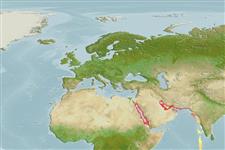>
Kurtiformes (Nurseryfishes, cardinalfishes.) >
Apogonidae (Cardinalfishes) > Apogoninae
Etymology: Cheilodipterus: Greek, cheilos = lip + Greek, di = two + Greek, pteryx = fin (Ref. 45335).
Environment: milieu / climate zone / depth range / distribution range
Ökologie
seewasser demersal. Tropical
Western Indian Ocean: Gulf of Aqaba and Ethiopia in the Red Sea.
Size / Gewicht / Alter
Maturity: Lm ? range ? - ? cm
Max length : 5.0 cm SL (female)
Color in life pale brownish gray with 5 dark brown to black stripes narrower than interspaces. A black spot, pupil size or slightly larger, laterally on middle of caudal peduncle. A small black spot on dorsal surface and another, less distinct, on ventral surface of caudal peduncle. Midcaudal spot encircled by yellow except for a small white area on posterodorsal section of caudal peduncle. Snout darker than body. Anterior 2 dorsal spines and tip of third spine dark with dusky membranes. Posterior spines of first dorsal fin dusky with transparent membranes. Spines of second dorsal and anal fins, and anterior edge of pelvic fins dusky to dark, but not as dark as dorsal fin spines. Fins otherwise transparent (Ref 8525).
Smallest female with mature gonad and large eggs measured about 3 cm.
Life cycle and mating behavior
Geschlechtsreife | Fortpflanzung | Ablaichen | Eier | Fecundity | Larven
Mouthbrooders (Ref. 240). Distinct pairing during courtship and spawning (Ref. 205).
Gon, O., 1993. Revision of the cardinalfish genus Cheilodipterus (Perciformes: Apogonidae), with description of five new species. Indo-Pac. Fish. (22):59 p. (Ref. 8525)
IUCN Rote Liste Status (Ref. 130435)
Bedrohung für Menschen
Harmless
Nutzung durch Menschen
Mehr Information
ReferenzenAquakulturAquakultur ProfilZuchtlinienGenetikElectrophoresesVererbbarkeitKrankheitenVerarbeitungNutrientsMass conversion
PartnerBilderStamps, Coins Misc.LauteCiguateraGeschwindigkeitSchwimmstilKiemenoberflächeOtolithsGehirngrößeSehfähigkeit
Tools
Zusatzinformationen
Download XML
Internet Quellen
Estimates based on models
Preferred temperature (Ref.
123201): 24.8 - 29.2, mean 27.5 °C (based on 337 cells).
Phylogenetic diversity index (Ref.
82804): PD
50 = 0.5000 [Uniqueness, from 0.5 = low to 2.0 = high].
Bayesian length-weight: a=0.00501 (0.00201 - 0.01253), b=3.26 (3.04 - 3.48), in cm total length, based on LWR estimates for this (Sub)family-body shape (Ref.
93245).
Trophic level (Ref.
69278): 3.5 ±0.6 se; based on size and trophs of closest relatives
Widerstandsfähigkeit (Ref.
120179): hoch, Verdopplung der Population dauert weniger als 15 Monate. (Preliminary K or Fecundity.).
Fishing Vulnerability (Ref.
59153): Low vulnerability (10 of 100).
